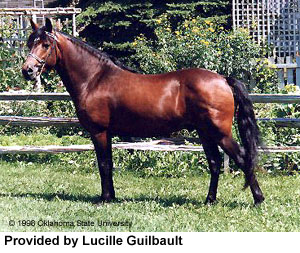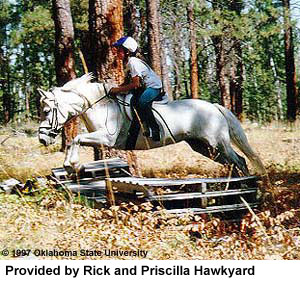

New Forest


Introduction: If you have any comments or suggestions, please click here.
Names: New Forest, New Forest Pony.
Origin: Lives
in the New Forest in southern England. (New Forest Pony Breeding and
Cattle Society.) Old breed of pony related to the Exmoor.
New blood, including Welsh, Western Islands, Thoroughbred
and especially Oriental, has frequently been introduced.
One of the nine presently recognized breeds of ponies in the
British Isles. The New Forest is today a stretch of sparsely wooded
grassland in Hampshire, comprising about 60,000 acres (or 94 square miles).
In it an estimated 1500 ponies run free throughout the year, along with grazing
cattle. Like other British semi-wild breeds, these ponies have inherited
hardiness and endurance from having had to live on a poor food supply,
especially during the winter, when they have had to dig out the sparse grasses
from under the snow. The origin of the breed is obscure, but it is thought
to have descended either from the Exmoor pony or from a common ancestor of the
two breeds. New Forest ponies are today being used in Sweden, Denmark,
Holland, and othe rEuropean countries as children's mounts and as show-ponies.
Since the late 1950s they have also been imported into the United States.
Breeding: Had a mixed heritage until fairly recent breeding within the breed helped to fix the type. Centuries of wet weather and sparse grazing during winter in the forest, have ensured survival of the fittest. New Forest ponies are increasingly popular in other countries.
Description: Can be various shapes. Today there is a growing demand for ponies up to 14.2 hands, despite some contentions that the larger type is untypical, and since it has to be hand-fed, may lose its inherent toughness.
Action: Satisfactory walk and trot. Able to gallop and jump.
Body: Shoulders often quite steep. Rather long, yet strong back. Quarters sometimes short.
Color: Any color except piebald or skewbald; bays and browns predominate.
Head: Frequently shows Arab influence. Rather long, well-set ears.
Legs: Position of limbs sometimes uneven; otherwise healthy and well marked.
Size: 12-14 hands. 12.2 to 14.2 hands. 49-57 inches.
Temperament: Naturally docile.
Features: They are good "doers" and very hardy. Rather large, well-made, hardy pony. Excellent children's riding pony of placid temperament and good character.
Uses: Good riding pony. Excellent mounts for children and light adults.
Accomplishments:
Curiosities: New Forest ponies are mentioned in the Domesday Book of 1085.
Profiles:
Conclusion: